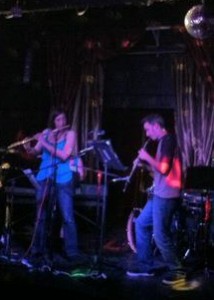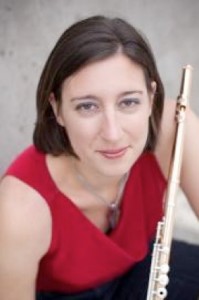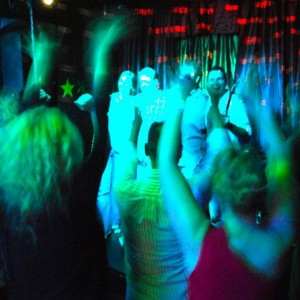[In her first post, Sarah Robinson talked about her own experience playing in clubs — a story full of dancing and happiness, plus genre-bashing and delighted audiences. Some people might not recognize what she and her ensemble did as classical music, but I’d say (as she does) that classical music is changing, and that what she’s done is part of our future.
[Now comes her second post, in which she talks about many classical musicians who play in clubs, showing us what that’s like, from a larger perspective. No one, to my knowledge, has written about this so thoroughly before. Sarah, as readers of the first post know, has written a doctoral dissertation on the subject, which you can download, if you follow the link at the end of the post.]
Critical Mass: The Making of a Club Scene
 During the early stages of the World Dance Club program, I was completing a doctorate at the University of South Carolina. When it came time to pick a dissertation topic, researching chamber music in alternative venues seemed like a great fit. The music school there has a forward-looking entrepreneurship program and, happily, they allowed me to pursue this research as a dissertation for a doctorate in flute performance!
During the early stages of the World Dance Club program, I was completing a doctorate at the University of South Carolina. When it came time to pick a dissertation topic, researching chamber music in alternative venues seemed like a great fit. The music school there has a forward-looking entrepreneurship program and, happily, they allowed me to pursue this research as a dissertation for a doctorate in flute performance!
I spoke to musicians, presenters and clubowners who worked with this kind of performance regularly. What I discovered was fascinating and exciting for the future of classical music. My blog host, Greg Sandow, has clearly explained here the decline in and aging of the audience for classical music in the last 30 years. I believe this shrinking audience, combined with an explosion of newly trained young classical musicians, were the intersecting forces that created the classical club scene.
Over the same time period as classical music lost generations of audience, more and more universities added degrees in music performance. From 1998 to 2010, the number of college arts degrees awarded annually in the United States rose steadily from 75,000 to 129,000, according to the Americans for the Arts: Arts Index. A huge number of classical performance graduates were unemployed or underemployed in their field in the first decade of the millennium. There were enough of us, in fact, to form communities around the country. We insisted on developing careers in music, despite a lack of traditional opportunities. Out of this wealth of trained classical musicians seeking creative outlets grew the alternative venue craze. Young professional musicians could present concerts in bars with relative ease and autonomy.
Young musicians also wanted to play for an audience of their own age. Trying to get my non-musician friends to a recital or symphony concert was like pulling teeth. Invite them to a club show, however, and they’re sure to stop by to check it out. Advertise a classical recital in a church, and you can count on the retiree set to show up. But when we advertised “Cello Madness” at the Silverlake Lounge in Los Angeles, all kinds of people in their 20s and 30s saw the calendar listing and turned up to see something different from the usual parade of rock bands.
Money, money, money, money
As we all know, if you want playing music to be a career and not just a hobby, you’ve got to earn income from your work. Can you earn money from club performances? Yes, you can. First, you can build an audience and attract media attention. This makes you more appealing to concert presenters and can help your ensemble increase bookings. Second, you can make money from the club shows themselves.
Profit on these shows varies widely, depending on the size of the crowd and the size and overhead of the ensemble. Musicians are most often paid by a percentage of the admission price, also known as the cover charge, or by direct donations from the audience. Covers generally range from $10 to $20 and ensembles usually receive 60 – 80% of that, with the remainder going to the club. Audience donations go entirely to the performers. Audience donations can be collected by leaving a tip jar at the bar or by passing one around. I’ve found the best way to solicit donations is with an in-person request, especially at the door of the club.If you ask for a suggested donation at the door, the vast majority of audience will give you something and will usually match the suggested amount.
When an ensemble or presenting organization has developed a relationship with a venue and a track record of attracting an audience, they are sometimes also offered a percentage of the bar proceeds during their set. Famous acts are occasionally offered a flat fee by a club but most performers are never offered anything like that. Clubs generally require no payment from performers and will provide sound equipment free of cost. Ensembles can usually sell their CDs and keep all of that revenue.
How this works out in practice is very simple: a larger audience means higher fees. For most of the artists I spoke to, their audience at clubs normally ranged from 40 to 150. Another factor is the number of performers. The fewer musicians performing, the more each one is paid. A solo cellist performing in the back room at Barbès in New York for 40 people, who each give the recommended $10 donation, will walk away from a two-hour set with $400. A string quartet that has an audience of 100 with a $15 cover and receives 70% of the door, will earn $1,050 as an ensemble, or about $260 per performer. When an ensemble or presenter plays regularly in the same place, audience size and income becomes more predictable. Like so much of what we do as freelance musicians, the income isn’t guaranteed but it can be regular enough to start to incorporate it into your monthly finances.
When there are a large number of performers or when an ensemble carries significant overhead, club concerts can be subsidized. The advantages in press coverage and audience-building are often worth the financial investment. Ensembles subsidize club performances with fees from the same tour for educational concerts and university residencies. Performers are sometimes paid a direct fee from presenting organizations for club shows. Others use their general fundraising and operating budget.
Sell it!
What these numbers mean is that musicians need to bring in an audience to bring home the bacon. So how do they get one? Well, they can use social media and email lists, they can create regular residencies in clubs, they can use terminology familiar to their audience, and they can share shows with an ensemble from another genre.
Social media is a powerful and constantly evolving tool. The rules are always changing and, increasingly, we are competing with big-money advertisers. Here is a recent article by Jon Ostrow on beating the Facebook system. But the best advice is to stay active and keep experimenting with multiple social media platforms.
Email lists are a safer bet for keeping in touch with interested fans. At Classical Revolution: LA we use the old-fashioned but effective method of bribery. In return for email addresses, we enter people in a raffle for a free CD or other prize given away at the show.
Performing at the same time and place each week or month helps an act build a reputation and makes it easy for fans to find the shows. When we established our monthly Classical Revolution: L.A. concerts at the Silverlake Lounge, within a few months we could count on a full bar. There is just no replacement for being a regular, consistent part of the nightlife of a city. When a Los Angeles Times reporter called to ask about our shows, the first thing she asked was: Is this recurring? Her paper only wanted to cover an event that readers would be able to go to again.
In advertising to younger audiences, classical groups performing in clubs often change terminology so that it sounds more familiar. Groups call themselves “bands” instead of “chamber ensembles,” and dub the performances “shows” rather than “concerts.” Nonclassical audiences are perfectly open to experimental, off-the-wall groups that may just happen to be classical, but you’ve got to tell them something interesting about the show to get them to come. Classical Revolution: L.A.’s “Battle of the Bands” events are packed because people understand the concept of a battle of the bands and are interested in a new twist on it.
Advertising based around a composer almost always falls flat. Most people don’t really know what a composer does. Advertise a group that plays its own music, however, and popular music fans are on board. Now they have some idea of what to expect and can be drawn in with a great review or an interesting personal story.
Finally, sharing a bill with an group from another genre can be extremely effective in expanding the audience for a particular ensemble or for classical music in general. Duo del Sol, a violin and guitar duo that will be joining Helix Collective as an ensemble-in-residence for Classical Revolution: L.A. next month, regularly performs with their sister rock band Magnolia Memoir. When they started playing shows together, the number of fans for Duo del Sol shot up exponentially. Ronen Givony, who books classical music for (le) Poisson Rouge in New York, used the pairing of indie-rock bands with classical acts to create the wildly successful Wordless Music Series. We all know that classical isn’t the most popular form of music these days, so why not ride some coattails? Classical musicians can certainly put on amazing shows once new fans are there to discover us.
What will happen to our beloved classics?
I can hear the howls now. What will be left of classical music after all these pandering, lowbrow, sellouts ruin the art form?
Take a deep breath and look at the history of classical music. This has all been done before. Bach played reading sessions in coffee shops and Schubert played waltzes on the piano for dancing at parties. Traditions of concert etiquette change. Concert venues come and go. New styles of classical music that incorporate popular music have emerged on a regular basis. The mazurka was a folk dance. Bernstein wrote a mambo. That doesn’t mean that older classical music disappears.
The soprano Katina Mitchell absolutely captivated a club audience at Classical Revolution: L.A. with a quiet, introspective set of renaissance songs. Classical Revolution in San Francisco regularly packs the Revolution Cafe with audiences coming to hear standard classical string quartets. Hybrid music from clubs and an entertaining stage presence also easily transition to the concert hall. Project Trio developed a unique style that combines beatboxing, classical and jazz in club performances. They also perfected a casual, fun style of presentation in these venues. Their performances work just as well on a concert stage and Project fans show up to hear them in any kind of venue.
I play classical music of all styles in a huge variety of settings. I don’t give up my orchestra gigs just because I play in clubs. Nobody I know does. I love playing in orchestras! I do have some ideas for making the concerts more fun, though. The presentation of classical music, along with the music itself, changes over time, but those of us who love the wide sweep of this music will bring it forward into the future.
The Golden Unicorn: Classical Audiences in their 20s and 30s
There’s one last point, something very important, something that I could write pages about. But I’ll just mention it quickly, because even though it’s crucially important, it’s also very simple. Club shows attract a young audience, people in their 20s and 30s. To be most effective in drawing that audience, the performers themselves should be young. The location itself isn’t enough. The entire operation needs to feel young, meaning that not just the performers but also the producers and in fact everyone involved in producing and marketing the shows should be young. So here’s a lesson for the classical music world. If you want to attract the lost generation of listeners, go to the places they hang out, and understand that they’ll be most attracted to performances by musicians their own age. Mainstream classical music groups should learn this lesson. Given how effective these concerts are in attracting a new audience to classical music, it makes sense for mainstream classical music organizations to jump onboard the club classical train. It’s taking off with or without them!
 Sarah Robinson is flutist and co-founder of the world/classical/rock group Helix Collective and director of Classical Revolution: L.A. Now entering its third year, Classical Revolution: L.A. hosts a dizzying array of classical and crossover artists at clubs around the city for regularly packed houses. The dissertation she mentions in this post, Chamber Music in Alternative Venues in the 21st Century U.S., can be downloaded here.
Sarah Robinson is flutist and co-founder of the world/classical/rock group Helix Collective and director of Classical Revolution: L.A. Now entering its third year, Classical Revolution: L.A. hosts a dizzying array of classical and crossover artists at clubs around the city for regularly packed houses. The dissertation she mentions in this post, Chamber Music in Alternative Venues in the 21st Century U.S., can be downloaded here.


This is fabulous!!! I love it. Great work and please continue to keep us informed and inspired.
“I play classical music of all styles in a huge variety of settings. I don’t give up my orchestra gigs just because I play in clubs.”
Ironically, I would give up my orchestral gigs if I were doing no teaching. Sadly, we have a little more legitimacy as an instructor of a traditionally classical instrument if we play some orchestral gigs. Or classical gigs for that matter. Before I started teaching and doing cello sectionals with young players all I was doing was non-classical gigging and have to admit that I’ve taken a little cut in revenue when I started teaching (thus picking up the classical gigs) again.